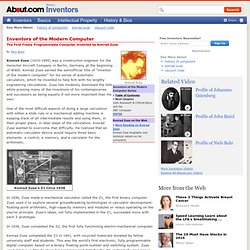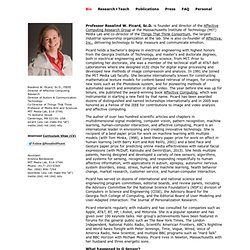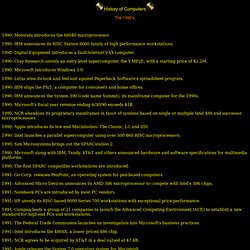

IBM 610 - The First Personal Computer. Columbia University Computing History [ French / français ] The IBM 610 Auto-Point Computer was designed in the portholed attic of Watson Lab at Columbia University by John Lentz between 1948 and 1954 as the Personal Automatic Computer (PAC) and announced by IBM as the 610 Auto-Point in 1957¹.

The IBM 610 was the first personal computer, in the sense that it was the first computer intended for use by one person (e.g. in an office) and controlled from a keyboard². The large cabinet contains a magnetic drum, the arithmetic control circuitry, a control panel, and separate paper-tape readers and punches for program and data (according to one former user, Russ Jensen, "The machine was programmed by a punched paper tape which duplicated itself in order to perform extra passes through the code". Brennan [9] says the first 610 prototype was "completed at Watson Lab in 1948". I was on the design team from Burroughs. Photos: From Reference 2, scanned by Ed Thelen. Onsite Links: The Digesting Duck in automatons. A mechanical duck, created by Jacques de Vaucanson, which gave the impression of eating kernels of grain, digesting and then defecating them.

Vaucanson hoped that it would be possible to create a future automaton that actually performed these actions rather than the sleight of hand he used. The Digesting Duck is a great example of technology harnessed for an entirely pointless purpose, although it did elevate the normally unpleasant process of digestion to something that became widely known across France and the western world. Even though it may lack a practical purpose at first glance, the Digesting Duck pioneered flexible rubber tubing, something that would quickly become useful for later inventions and industries.
You can see a replica of the duck in the Museum of Automatons in Grenoble, France. Have you seen M. Inventors of The Modern Computer - Konrad Zuse. By Mary Bellis Konrad Zuse (1910-1995) was a construction engineer for the Henschel Aircraft Company in Berlin, Germany at the beginning of WWII.

Konrad Zuse earned the semiofficial title of "inventor of the modern computer" for his series of automatic calculators, which he invented to help him with his lengthy engineering calculations. Zuse has modestly dismissed the title while praising many of the inventions of his contemporaries and successors as being equally if not more important than his own. One of the most difficult aspects of doing a large calculation with either a slide rule or a mechanical adding machine is keeping track of all intermediate results and using them, in their proper place, in later steps of the calculation. Konrad Zuse wanted to overcome that difficulty.
ALGOL. There were three major specifications: ALGOL 58 – originally proposed to be called IAL (for International Algebraic Language).ALGOL 60 – first implemented as X1 ALGOL 60 in mid-1960 – revised 1963[4][5]ALGOL 68 – revised 1973[6] – introduced new elements including flexible arrays, slices, parallelism, operator identification, and various extensibility features.

Algol 68 is substantially different from Algol 60 but was not well received, so that in general "Algol" means Algol 60 and dialects thereof. Fragments of ALGOL-like syntax are sometimes still used as pseudocode. Rodney Brooks. Rodney Allen Brooks (born December 30, 1954) is an Australian roboticist, Fellow of the Australian Academy of Science, author, and robotics entrepreneur, most known for popularizing the actionist approach to robotics.

He was a Panasonic Professor of Robotics at the Massachusetts Institute of Technology. He is a founder and former Chief Technical Officer of iRobot[1] and co-Founder, Chairman and Chief Technical Officer of Rethink Robotics (formerly Heartland Robotics). Outside the scientific community Brooks is also known for his appearance in a film featuring him and his work, Fast, Cheap, and Out of Control.[2] Life[edit] Brooks received a M.A. in pure mathematics from Flinders University of South Australia. In 1981, he received a Ph.D. in Computer Science from Stanford University under the supervision of Thomas Binford.[3] He has held research positions at Carnegie Mellon University and MIT and a faculty position at Stanford University.
Work[edit] Timeline of Robots. History of Robots. Robots have long been part of the public imagination.

They have been portrayed in movies - notably, in Metropolis, the Star Wars series, Star Trek, The Day The Earth Stood Still, Blade Runner and Silent Running - and have found mention in science-fiction literature. The word 'Robot', derived from the Czech work 'Robota' (compulsory labor), was in fact first mentioned in the 1920 Czech play "R.U.R" by Karel Capek; in the play, robots used in war turn against their human masters and take over the world.
Robot Timeline - Robotic History. Rosalind W. Picard. Professor Rosalind W.

Picard, Sc.D. is founder and director of the Affective Computing Research Group at the Massachusetts Institute of Technology (MIT) Media Lab and co-director of the Things That Think Consortium, the largest industrial sponsorship organization at the lab. She is also co-founder of Affectiva, Inc., delivering technology to help measure and communicate emotion. Picard holds a bachelor's degree in electrical engineering with highest honors from the Georgia Institute of Technology, and master's and doctorate degrees, both in electrical engineering and computer science, from MIT. Prior to completing her doctorate, she was a member of the technical staff at AT&T Bell Laboratories where she designed VLSI chips for digital signal processing and developed new methods of image compression and analysis. In 1991 she joined the MIT Media Lab faculty.
Rosalind Picard. Rosalind Picard at the Veritas Forum Science, Faith, and Technology session on "Living Machines: Can Robots Become Human? " Rosalind W. Picard (born May 17, 1962 in Massachusetts) is Professor of Media Arts and Sciences at MIT, director and also the founder of the Affective Computing Research Group at the MIT Media Lab, co-director of the Things That Think Consortium,[1] and chief scientist and co-founder of Affectiva.[2][3] In 2005, she was named a Fellow of the Institute of Electrical and Electronics Engineers.[4] John McCarthy (computer scientist) American computer scientist and cognitive scientist It was at Caltech that he attended a lecture by John von Neumann that inspired his future endeavors.

After short-term appointments at Princeton and Stanford University, McCarthy became an assistant professor at Dartmouth in 1955. History of Computers 1990. History of Computers The 1990's, 1990: Motorola introduces the 68040 microprocessor. 1990: IBM announces its RISC Station 6000 family of high performance workstations. 1990: Digital Equipment introduces a fault-tolerant VAX computer. 1990: Cray Research unveils an entry-level supercomputer, the Y-MP2E, with a starting price of $2.2M. 1990: Microsoft introduces Windows 3.0. 1990: Lotus wins its look and feel suit against Paperback Software's spreadsheet program. 1990: IBM ships the PS/1, a computer for consumers and home offices.

Joseph Weizenbaum. Joseph Weizenbaum (8 January 1923 – 5 March 2008) was a German and American computer scientist and a professor emeritus at MIT.

The Weizenbaum Award is named after him. Life and career[edit] Born in Berlin, Germany to Jewish parents, he escaped Nazi Germany in January 1936, emigrating with his family to the United States. He started studying mathematics in 1941 at Wayne University, in Detroit, Michigan. Contact us – Contact us – Google. Social intelligence. Social intelligence is the capacity to effectively negotiate complex social relationships and environments.[1] Psychologist Nicholas Humphrey believes that it is social intelligence, rather than quantitative intelligence, that defines humans. Social scientist Ross Honeywill believes social intelligence is an aggregated measure of self- and social-awareness, evolved social beliefs and attitudes, and a capacity and appetite to manage complex social change. A person with a high social intelligence quotient (SQ) is no better or worse than someone with a low SQ, but they have different attitudes, hopes, interests and desires.[2] Neural network.
An artificial neural network is an interconnected group of nodes, akin to the vast network of neurons in a brain. Here, each circular node represents an artificial neuron and an arrow represents a connection from the output of one neuron to the input of another. For example, a neural network for handwriting recognition is defined by a set of input neurons which may be activated by the pixels of an input image. After being weighted and transformed by a function (determined by the network's designer), the activations of these neurons are then passed on to other neurons.
This process is repeated until finally, an output neuron is activated. Kismet (robot) Kismet is a robot made in the late 1990s at Massachusetts Institute of Technology by Dr. Cynthia Breazeal. The name Kismet comes from the Turkish word meaning "fate" or sometimes "luck".[1] In addition to the computers mentioned above, there are four Motorola 68332s, nine 400 MHz PCs, and another 500 MHz PC.[1] Kismet's social intelligence software system, or synthetic nervous system (SNS), was designed with human models of intelligent behavior in mind.
It contains six subsystems[2] as follows. This system processes raw visual and auditory information from cameras and microphones. Kismet's audio system is mainly tuned towards identifying affect in infant-directed speech. Dr. Timeline of artificial intelligence. The Logic Theorist. The Logic Theorist and its children: AI in action In 1956, Allen Newell, J.
C. Shaw, and Herbert created a program called the Logic Theorist, arguably the first program to show novel behavior and thus count as "artificial intelligence. " Logic Theorist. The History of AI. As of July 1, 2013 ThinkQuest has been discontinued. We would like to thank everyone for being a part of the ThinkQuest global community: Students - For your limitless creativity and innovation, which inspires us all. Artificial intelligence. 10 Ways Artificial Intelligence Will Affect Our Lives. ELIZA effect. The ELIZA effect, in computer science, is the tendency to unconsciously assume computer behaviors are analogous to human behaviors. ELIZA'S WORLD by Nicholas Carr. Eliza, Computer Therapist. Supercomputers solve riddle of congenital heart defects.
Both heredity and environment play a role in congenital heart defects, but exactly how various risk factors influence the development of the heart during pregnancy has been a mystery -- until now. National Aerospace Laboratory of Japan's Numerical Wind Tunnel-Computer Museum. History of Computers 1930. Contact. Control Data Corporation (CDC) 6600.
National History Day Contest. Officers and Directors - Robert E. Kahn. The Super Computer Timeline. ARPANET. Z1 (computer) Supercomputer. CDC 6600. Cray-1. Littlebear: The Connection Machine 5. Cray, the Supercomputer Company. Cray-2. ELIZA. History of the Internet. Who invented the Internet? The 10 Founding Fathers of the Web. History of the web. The History of Computers - Computer History Timeline. Computer History Museum. Computer History Museum - Exhibits - Internet History. What is IPTO (Information Processing Technology Office)? A Conversation with Internet Inventors. Bob Kahn. Vint Cerf. Steve Crocker. Leonard Kleinrock. Paul Baran. J. C. R. Licklider. Donald Davies. Vannevar Bush. Seymour Cray.